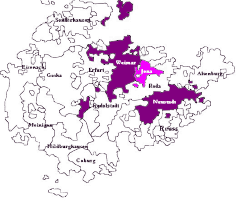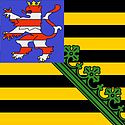Saxe-Weimar
Saxe-Weimar (German: Sachsen-Weimar) was a duchy in Thuringia, Germany. The chief town and capital was Weimar.
Duchy of Saxe-Weimar Herzogtum Sachsen-Weimar | |||||||||
|---|---|---|---|---|---|---|---|---|---|
| 1572–1809 | |||||||||
 | |||||||||
| Status | State of the Holy Roman Empire, then State of the Confederation of the Rhine | ||||||||
| Capital | Weimar | ||||||||
| Government | Feudal monarchy | ||||||||
| Historical era | Early modern period | ||||||||
• Division of Erfurt | 1572 | ||||||||
| 1602 | |||||||||
| 1640 | |||||||||
| 1672 | |||||||||
| 1741 | |||||||||
| 1809 | |||||||||
| |||||||||
| Today part of | |||||||||
History
changeSaxe-Weimar and Saxe-Gotha were the two original Ernestine Duchies. They both gradually shrank in size as land in Thuringia was divided among sons..
In 1741 Duke Ernest Augustus I of Saxe-Weimar inheritated the Duchy of Saxe-Eisenach. Ernest Augustus II, who succeeded in 1748, died in 1758, and his young widow, Anna Amalia, became regent for her infant son, Charles Augustus. The regency of Anna Amalia and the reign of Charles Augustus were important in the history of Saxe-Weimar. Both intelligent patrons of literature and art, Anna Amalia and Charles Augustus attracted to their court the leading scholars in Germany, including Goethe, Schiller and Herder, and made Weimar an important cultural centre.
Charles Augustus joined Prussia in the Napoleonic Wars. After France won the Battle of Jena, Saxe Weimar was forced to join the Confederation of the Rhine in 1806. In 1809 Saxe-Weimar and Saxe-Eisenach, which had been separate duchies with the same duke became one country as the Duchy of Saxe-Weimar-Eisenach.
Dukes of Saxe-Weimar
change- Johann Wilhelm (1554 – 73)
- Frederick Wilhelm I (1573 – 1602), son of Johann Wilhelm
- Johann (1602 – 05), son of Johann Wilhelm
- Johann Ernst I (1605 – 20), son of Johann
- Wilhelm (1620 – 62), son of Johann.
- Johann Ernst II (1662 – 83), son of Wilhelm
- Wilhelm Ernst (1683 – 1728), son of Johann Ernst II
- Johann Ernst III (1683 – 1707), son of Johann Ernst II
- Ernst August I (1707 – 48), son of Johann Ernst III
- Ernst August II (1748 – 58), son of Ernst August I
- Karl August (1758 – 1809), son of Ernst August II
Merged with Saxe-Eisenach to form Saxe-Weimar-Eisenach
Related pages
changeReferences
change| This article includes text from the public domain 1911 Encyclopaedia Britannica. Please add to the article as needed. |
- Saxe-Weimar Archived 2005-12-05 at the Wayback Machine, The Columbia Electronic Encyclopedia, Sixth Edition, Columbia University Press (2001 – 2005), accessed December 22 2005
Other websites
change- German genealogies
- Genealogy of Dukes of Saxe-Weimar (in French)

